Tea whisk, Shinkazuho, Shiratake, two-color thread (yellow and white) / Tango Tanimura
- Regular price
-
¥5,500 - Regular price
-
- Sale price
-
¥5,500
A color that lets you feel the power of yellow.
Bamboo also has natural patterns that give it a luxurious feel.
Takayama, Ikoma-gun, Nara Prefecture is the only tea whisk producing area in the world.
All tea whisks are harvested at the right time, dried over a period of time, and only the most suitable parts are used, and each one is carefully handmade by a craftsman.
The "Shinkazuho" does not have a rounded tip. It is more durable than the "Kazuho" which has a traditional rounded tip.
<From the artist>
Tango Tanimura was born in Takayama, Ikoma, Nara Prefecture in 1964, and is the 20th head of the Tanimura family, having mastered the secret teachings of only one son, just like his ancestors. Takayama has been the center of Japanese tea whisk making for over 500 years, and the Tanimura family is one of three surviving families of the thirteen tea whisk masters who were given surnames by the Tokugawa Shogunate during the Edo period.
Tea whisk materials
Making a tea whisk begins with determining the properties of the bamboo material.
There are more than 100 different types of chasen, and the materials used vary depending on the school.
They are divided into soot bamboo of the Omotesenke school, light bamboo of the Urasenke, Yabunouchi school, Enshu school, etc., and purple bamboo (black bamboo) of the Mushakojisenke school.
The bamboo rafts used for tea whisks are usually two or three years old, cut in the middle of winter and boiled.Then, they are exposed to sunlight for a month and then dried in the shade in a barn for another year or two to ensure that they are free of cracks and discoloration.
| Katagi | The bark above the nodes is scraped off and the bamboo is split into 16 pieces. |
|---|---|
| Small division | Divide into the number of ears according to the type |
| Flavor Shavings | The carving method changes depending on the school to create distinctive shapes |
| Chamfering | Remove the outer edge of the ear |
| Lower knitting | The outer ear is raised and thread is attached. |
| Top Knitting | Thread the yarn two more times. |
| Finishing | Adjust the overall shape |
All work is done using the unique characteristics of each bamboo and relying on the sense of touch in the fingertips.
To prepare delicious matcha, you need a good chasen made by skilled hands using carefully selected bamboo.
It takes about two hours to make one chasen (excluding the time it takes to soak it in water to soften it), and if one person does the entire process, they can only make five or six a day.
The origin of Takayama Chasen
It is said that in the late Muromachi period, the second son of Yamato Yozan's sensibility Takayama Daizensuke Yoriei invented the tea whisk with advice from Murata Juko, the head priest of Shomyoji Temple in Nara at the time.
He passed on the techniques of making tea whisks to his retainers in the Takayama clan, and made them as a side job, but after the Takayama clan fell, the place name was changed to "Takayama" and making tea whisks became his livelihood. After that, demand increased with the rise of the tea ceremony, and the industry was favored as a protected industry by Toyotomi Hideyoshi and the Tokugawa Shogunate.
The name "Tango" is recorded in our family as the tea whisk maker of choice for the Tokugawa Shogunate, and wooden tags and lantern boxes used for deliveries to the Sento Imperial Palace, nobles, and various feudal lords have been preserved.
Couldn't load pickup availability




Tea whisk, Shinkazuho, Shiratake, two-color thread (yellow and white) / Tango Tanimura
- Regular price
-
¥5,500 - Regular price
-
- Sale price
-
¥5,500


